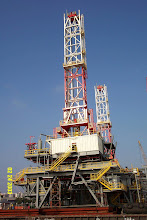Subscribe to RSS headline updates from:
Powered by FeedBurner
Friday, January 30, 2009
Tuesday, January 20, 2009
Thursday, December 4, 2008
Oil Field Equipment : Wholesale at PumpJackstore.com



If you are looking for wholesale prices on oilfield equipment please visit our site at
WWW.PUMPJACKSTORE.COM
Wednesday, December 3, 2008
Oil Field Equipment

Oil field equipment can consist of many things. I would like to explain some of the largest oil field equipment. A land rig and an off shore rig and the difference between the two.
A drilling land rig is a equipment which creates holes (usually called boreholes) and/or shafts in the ground. Drilling land rigs can be massive structures housing equipment used to drill oil wells, or natural gas extraction wells. They sample sub-surface mineral deposits, test rock, soil and groundwater physical properties. Drilling land rigs can be mobile equipment mounted on trucks, tracks or trailers, or more permanent land not to be confused with marine-based structures (such as oil platforms, commonly called 'offshore oil rigs'). The term "rig" therefore generally refers to the complex of equipment that is used to penetrate the surface of the earth's crust. A drilling land rig would be used on shore.
Drilling land rigs can be:
• Small and portable, such as those used in mineral exploration drilling.
• Huge, capable of drilling through thousands of meters of the Earth's crust. Large "mud pumps" circulate drilling mud (slurry) through the drill bit and the casing, for cooling and removing the "cuttings" while a well is drilled. Hoists in the rig can lift hundreds of tons of pipe. Other equipment can force acid or sand into reservoirs to facilitate extraction of the oil or mineral sample; and permanent living accommodation and catering for crews which may be more than a hundred.
Marine rigs may operate many hundreds of miles or kilometres offshore with infrequent crew rotation. An offshore platform, often referred to as an oil platform or oil rig, is a large structure used to house workers and machinery needed to drill wells in the ocean bed, extract oil and/or natural gas, process the produced fluids, and ship them to shore. Depending on the circumstances, the platform may be attached to the ocean floor, consist of an artificial island, or be floating.
Most offshore rigs are located on the continental shelf, though with advances in technology and increasing crude oil prices, drilling and production in deeper waters has become both feasible and economically viable. A typical offshore rig may have around thirty wellheads located on the platform and directional drilling allows reservoirs to be accessed at both different depths and at remote positions up to 5 miles (8 kilometres) from the platform.
Remote subsea wells may also be connected to a platform by flow lines and by umbilical connections; these subsea solutions may consist of single wells or of a manifold centre for multiple wells.
For more information on oil field equipment please visit
Top Stories

